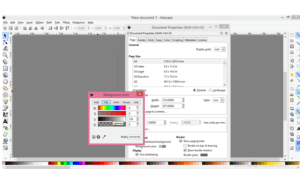
Now that you’ve outlined your text, it’s time to make some fine adjustments to some of the outline’s properties, including: You can adjust that further in the next steps. This will add an outline around your text in the color that you choose: This outline is what’s known as a stroke in Inkscape.ĭon’t worry if the outline is not in the color you’d like. With your text selected, hold Shift on your keyboard and click on one of the colors in the color palette at the bottom of your screen. You will now you text object is selected when there’s a dotted bounding box around it and arrows in all of the corners: In order for the stroke to be applied, you must have your text selected as I do in the screenshot above.

Grab the Select Tool (keyboard shortcut: S) and then make sure your text is selected. This is what will act as the outline around your text. Once you have your text object in place, it’s time to add a stroke. You can outline whatever you’d like using this process. So you don’t necessarily have to use text for creating your outline. And just to clarify: this method works with any vector object. If you already have a text object then you can proceed to step 2. The text can be any font, style, or word that you’d like. Export your palette with Extensions > Ink/Stitch > Thread Color Management > Generate Palette > Generate Color Palette.
Inkscape change text color update#


Inkscape palettes are found on the bottom to the right of the color swatches.Ĭlick on the little arrow to open a list of installed palettes and choose the manufacturer color palette depending on the thread you are willing to use. Ink/Stitch usually discoveres the correct path for your system by itself.
Inkscape change text color install#
Info: Just click install if you are not sure where to install the palettes. Go to Extensions > Ink/Stitch > Thread Color Management > Install thread color palettes for Inkscape.This allows to build the designs with the correct colors in mind.Ĭolors will appear in the PDF-Output and will also be included into your embroidery file, if your file format supports it. Ink/Stitch comes with a lot of thread manufacturer color palettes which can be installed into Inkscape. Install Thread Color Palettes for Inkscape gpl color palettes can be generated with Generate Color Palette. You will need to restart Inkscape after this process. Make it available in Inkscape with this extension: Extensions > Ink/Stitch > Thread Color Management > Install custom palette. gpl color list of the threads you are actually using. Restart Inkscape to activate the new color palette.Specify the name for your color palette and click on apply.Select the text elements and run Extensions > Ink/Stitch > Thread Color Management > Generate Palette > Generate Color Palette.Activate the color picker tool (D) and color the text elements, while using tab to select the text elements.Use Extensions > Ink/Stitch > Thread Color Management > Generate Palette > Split Text extension to split a text block with multiple lines into separate text elements.If the last part of a color name is a number, it will be used as the catalog number. Activate the text tool and copy & paste the color names (if you have them) or type them in.Import an image with the thread colors you want to use for the color palette.This extension will export colors of text elements while using the text as color names and numbers. But it doesn’t allow us to order color swatches properly.

Threadlists can only be exported through a zip-file ( batch export). Tipp: Install Add-Ons for Ink/Stitch to have more threadlists available. If you want to import any other threadlist from a txt-file, choose the option “Import other threadlist” and pick a threadlist from the dropdown menu before clicking on apply. to apply a threadlist exported by Ink/Stitch. Run Extensions > Ink/Stitch > Thread Color Management > Import Threadlist. In case you are planing to change these, you’d prefer to save the entire SVG instead. But be careful not to change the amount and order of colors. You can export and import them as you like. It could also be helpful, if you are wanting to test different color settings. This is especially useful, if you want to work on existing embroidery files which do not support color information (e.g. Ink/Stitch can apply a threadlist to an embroidery design.


 0 kommentar(er)
0 kommentar(er)
